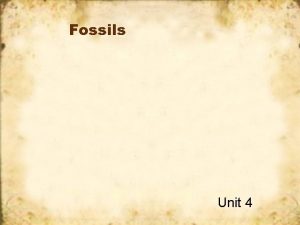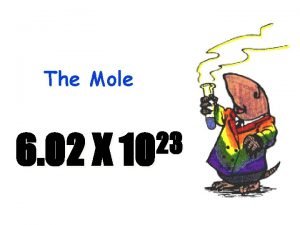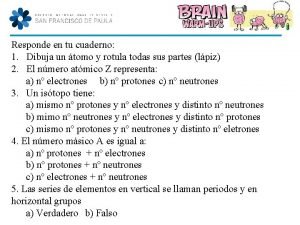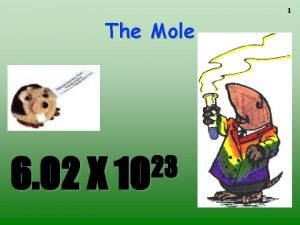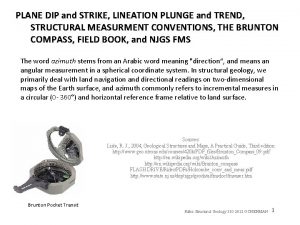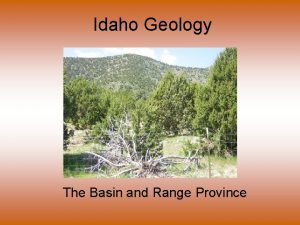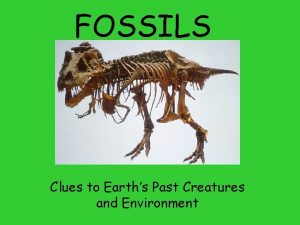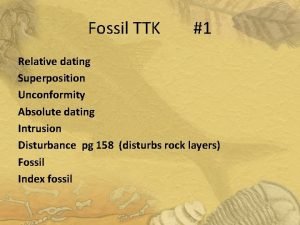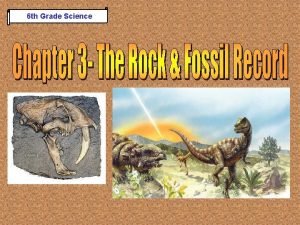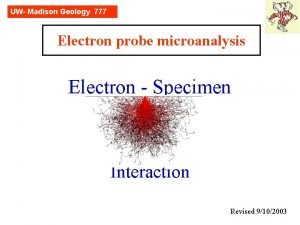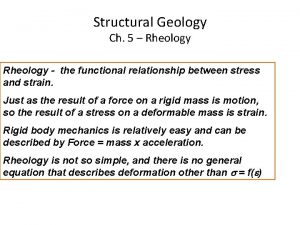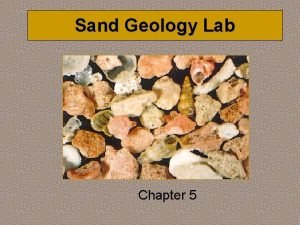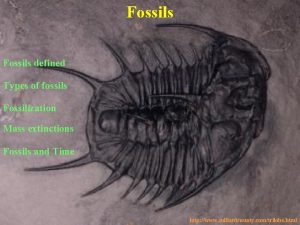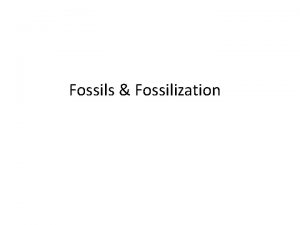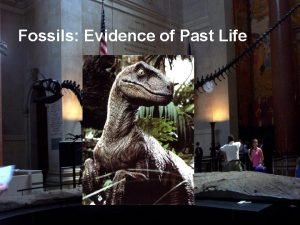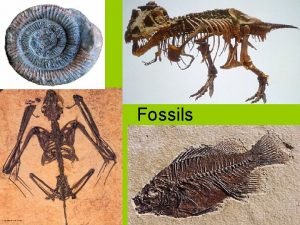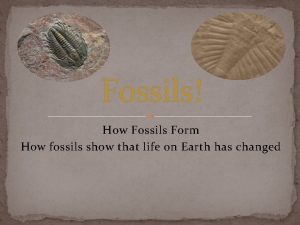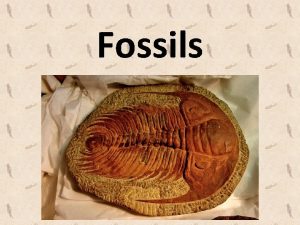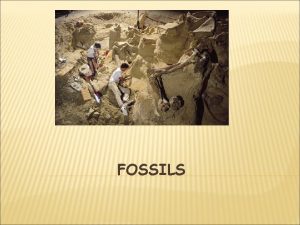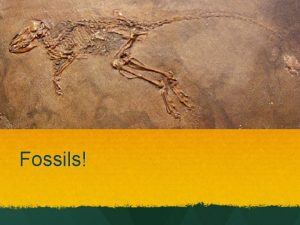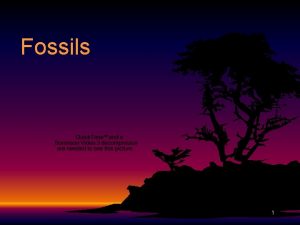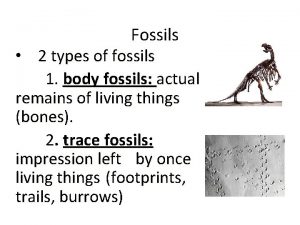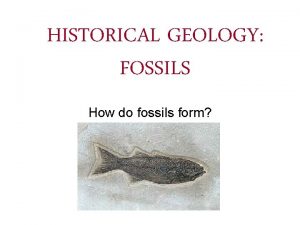Geology 1023 Fossils and fossilization Importance of fossils























- Slides: 23

Geology 1023 Fossils and fossilization

Importance of fossils • Examination of fossils over Earth history shows the evolution of life through time • Because fossils show a continuous change through time and no fossils disappear and reappear later, they can be used to give relative ages of fossil-bearing strata • Strata bearing the same fossil assemblage can be correlated (even without knowing their age) • Fossils indicate environment of deposition • Fossils can constitute most of a rock

Kinds of fossils • Body fossil: a part of an organism, such as a bone, tooth, scale, etc. • Trace fossil: evidence of organism’s activity, such as a footprint, burrow, feeding trace, etc.

Modes of preservation • Body fossils are commonly replaced or “altered” in some way but occasionally one can find original material (particularly in young rocks) • Replacement: substitution of the original material by inorganic mineral precipitation (most easily seen when new material cannot be organically produced, such as pyrite, etc. ). Replacement often destroys fine details of a fossil (e. g. , the fine internal laminar structure of shells)

Modes of preservation • Permineralization: a form of replacement with near-cellular level of replacement of original material preserving details down to the cellular level (e. g. , fossil wood in which treering and cell structure is preserved) • Mold: an impression left by a fossil in a rock/sediment (with “negative” geometry) • Cast: results when a mold is infilled by new material (producing the same geometry as the original)


Likelihood of preservation • Not all organisms are equally likely to be preserved in the fossil record. • Factors that increase the likelihood of preservation include: • Hard parts: organisms with mineralized elements of their bodies, such as shells, skeletons, teeth, scales, etc. , are more likely to be preserved than “soft-bodied” organisms like jelly-fish, sea anemones, etc.

Likelihood of preservation • Abundance: the more abundant an organism the greater the likelihood of preservation. Factors that influence overall abundance include: – Size: The smaller an organism the greater the number of fossils (microfossils are much more abundant than large dinosaurs) – Geographic distribution: the more widely distributed the greater the overall numbers – Species time span: The longer an organism lived the greater the numbers

Likelihood of preservation • Environment: Organisms that live in depositional environments are more likely to be preserved than those in erosive ones – Marine organisms > non-marine (fresh water) > terrestrial (landbased) > aerial. – Infauna (burrowers) > epifauna (crawlers or swimmers)

Likelihood of preservation • Rapid deposition environments – Preserve larger numbers of individuals – Preserve greater variety of organisms – Commonly have greater quality of preservation

Naming of fossils • Follow the same classification scheme developed initially for living organisms. • 7 major categories: – Kingdom, Phylum, Class, Order, Family, Genus, Species – Each category contains one or more members of the subsequent category. (I. e. , kingdoms contain one or more phyla, which contain one or more classes, etc. ) – In detail there are often other divisions such as sub- or superclasses, families, etc.

Conventions for naming fossils • Classification scheme invented by Carl Linneus and still called the Linnean classification scheme. • Each organism has a 2 -fold name, the genus and species • When written down, the genus is ALWAYS capitalized, and both genus and species are underlined when writing by hand. (In printed works they are italicized). It is also common when repeatedly referring to an organism to abbreviate the genus to its initial, hence T. rex (when written by hand) or T. rex (when printed)

Doing the lab. • Q 1 and Q 2 relate to the Linnean classification scheme (familiarization exercise) and the conventions of nomenclature • Q 3 and Q 4 get you thinking about the factors that increase likelihood of preservation. In each case there is a clear “winner” and “loser” (don’t worry about the ones in the middle so much)

Doing the lab. • Q 5. Look at the examples of different kind of preservation (back left of lab), labeled “Collection #1”. • Compare “collection 2” (2 sets to help with number of people in lab) to collection 1 examples to determine the mode of preservation.

Doing the lab. • Q 6. Look at the fossils for the Windsor and Horton groups at the back of the lab (“Collection # 3” and “Collection 4”) and think about environment of deposition. Indicate why.

Doing the lab. • Fossil assemblages in a rock are like a snapshot of life at the time • This is similar to the way that you can “date” a photograph to a particular era and place. For example, a photograph of Adolph Hitler in Nazi uniform must date from the 1930 s or ‘ 40 s, and would most likely have been taken in Europe

Doing the lab • Q 7. Using the example of a fictitious photograph, and knowing information about the items shown in the photograph you can “date” the photography by filling in the table with the time range for each item and then noting the time common to all 3

Photo to rock analogy • Though one can determine a possible range for the photo (such as 1990 to 1992) that does not mean the photo took 2 years to take. It represents an instant in that time period. • Likewise, though fossils give a possible range for a bed containing them, it does not mean that the bed took that entire time to be deposited. Like a photo, a fossil assemblage represents an “instant” in its possible time period.

Working with real fossils • For Q 8 and Q 9, use the fossils one of the six drawers labeled “Rocks and Fossils” at the back of the lab. • Identify the fossils using the simple identification handout. This takes a little time but you’ll get faster at it with practice. • Note that for each fossil shown in the handout the label given is the genus. Also shown is its time range. L. stands for lower, M. stands for middle and U. stands for upper.

Using the handout • Imagine that you’ve identified a fossil with this image. The handout has two images to show the fossil in different orientations. • Write down Schizophoria as the genus (i. e. , capitalized and underlined). • Its age is Silurian to Permian (X in the squares, including Sil. & Perm. ) • Note also that the image is half the actual size (x ½)

Ages determined using fossils • In Q 10 you will use the fossil ages determined in Q 8 and Q 9 to “bracket” the age of another unit. • Keep in mind that a fossil age (range) represents a span of time within which the unit was laid down.

Final points • Take the entire drawer to your table. Don’t remove the vials, bring them to the table and then replace them in the drawer. This leads to misplaced fossils. • You may take the fossil out of the plastic vial, but do so one -at-a-time and replace it before opening another. • When you write down the genus in the tables in Q 8 and 9 remember that you MUST underline it. You WILL lose marks for not underlining in this lab and any future lab or lab test.

Questions?
 Semantic fossilization
Semantic fossilization Trace fossils
Trace fossils American airlines flight 1023
American airlines flight 1023 Moles is equal to
Moles is equal to Formula para moles
Formula para moles 6 02 x 1023
6 02 x 1023 6 023 x 1023
6 023 x 1023 6 02 x 1023
6 02 x 1023 Tmk1023
Tmk1023 Massa dari 6,02 x 1022 atom mg (ar mg = 24) adalah
Massa dari 6,02 x 1022 atom mg (ar mg = 24) adalah How to measure trend and plunge
How to measure trend and plunge Latvian environment, geology and meteorology centre
Latvian environment, geology and meteorology centre Basin and range geology
Basin and range geology Tar fossil
Tar fossil Realtive dating
Realtive dating Chapter 21 fossils and the rock record answer key
Chapter 21 fossils and the rock record answer key Relative dating
Relative dating Xvfk
Xvfk Geology
Geology Geology what is
Geology what is Structural geology
Structural geology Law of unconformities
Law of unconformities Geology lecture series
Geology lecture series Grain size card
Grain size card

